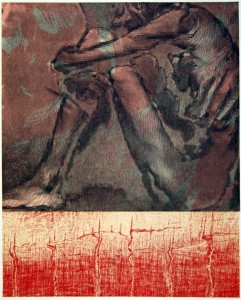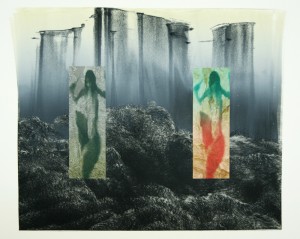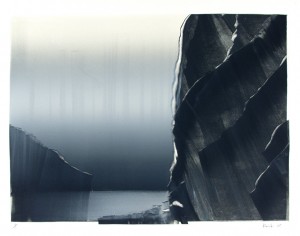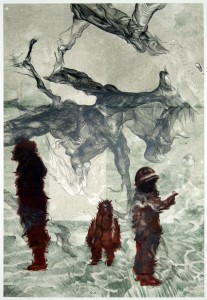McClain’s:
How were you first exposed to printmaking?
Koichi:
When I was about five years old, my uncle brought home a red snapper. He inked the fish, then printed it on shoji paper. This gyotaku, along with eating the “plate,” made a strong and lasting impression on me.
An example of making a gyotaku print:
httpv://www.youtube.com/watch?v=S4BdgXIqxY8
Thanks to seahunter1 for the great video!
McClain’s:
What inspires your work?
Koichi:
I am inspired by anyone who celebrates their existence and appreciates the place they live. I receive energy from the indomitable spirit of all living things, including this planet. I am always amazed and fascinated with life. Ordinary is an illusion, every moment of living is a miracle.
McClain’s:
You studied at the University of Alberta (MFA 1999), Pacific Northwest College of Art (BFA 1992) the Bratislava Academy of Art and the Poznañ Academy of Art. What led you to seek an education in so many places?
Koichi:
I think it was rooted in curiosity as well as dreaming and believing in my passion. Somehow it ended up this way. I did not plan it.
McClain’s:
How would you describe your creative process?
Koichi:
My creative process consists of about 2% thorough planning and 98% improvisation. I may have an idea when I go to the studio, but many theories fail during investigation which leads to new passages. I allow myself many failures, then explore the unintended consequences. Often the byproduct of initial attempt contains profound meaning. I think navigating the passages is more significant than the finalized state.
McClain’s:
Any carving/printing secrets you’d like to reveal or advice you’d like to pass along?
Koichi:
When I was learning copper engraving in Bratislava, Slovakia, my professor Dusan Kallay told me; “First you have to learn ice skating.” I never excelled at that, but became proficient at snowboarding while living in Utah. It’s the process of understanding the material you are carving, whether ice, snow, wood, or copper.
Other advice? Keep your tool sharp. Breathe out when you travel the surface. Play with speed and rhythm sometimes. Take frequent breaks to evaluate your actions. Most of all, stay hydrated.
McClain’s:
Do you keep a sketch book? If you keep one, how do you translate/transfer your sketched images to printed images?
Koichi:
Yes, it is an essential part of the process. A sketch book serves many purposes for me: capturing ideas along with feelings towards the work, noting approaches for how to execute the print, and recording my first impression when I see the print. Printing is a very long procedure. When you get used to seeing the work, it is difficult to retain the original visual impact. Take a lesson from the red snapper and print while it’s alive.
McClain’s:
Do you have a favorite print you’ve done and if so why?
Koichi:
I have many favorites, but it always changes. Maybe that’s why I keep making new favorites?
McClain’s:
How do you decide to use one printmaking technique over another?
Koichi:
For me, printmaking is the process of recording time. Some techniques are fast and dynamic. Others are slow and timid. Perhaps it’s similar to creating music? I like to combine different layers of markmaking on the same surface.
McClain’s:
How do you know when a print is done?
Koichi:
I never do. In other words, I keep it slightly incomplete. This way the next time I see the print, my ideas for solving the remaining problems will be unbounded. In Japanese, there is a concept called “mujinzou.” It means although a physical item is finite, ideas about it are infinite. Imagination is one resource of which I never have a shortage.
McClain’s:
Can you describe your studio space where you typically work?
Koichi:
I work in the print studio at the University of Tennessee in Knoxville. It is a large space, enlivened by the activities of colleagues, visiting artists, and students. Since it is my “home,” people in the studio are like my family. Printmaking is a communal activity from which many valuable dialogues emerge. I feel fortunate to be able to work there. https://art.utk.edu/printmaking/facilities/
Check out Betsy, UTK’s Conrad Press with a bed that’s 5×10 FEET!
McClain’s:
Of the processes you work with which do you enjoy the most and why?
Koichi:
I enjoy carving on copper. It is a slow process; calculated yet expressive. I also like creating large monotypes without any planning in advance. From the perspective of recording activities on paper, both share the property of flowing motion. The difference lies in my perception of suspended time. For example, it can feel like the same amount of time has elapsed whether I spend five hours carving on copper or thirty seconds pushing ink on plexiglass.
McClain’s:
Do you ever get “printer’s block” and if so what do you do to overcome it?
Koichi:
All the time. Perhaps I’ve always had “printer’s block” and not been aware of it. Consistency is critical to overcoming it. Just going to the studio will lead to some kind of opening. It’s also important to balance creation with recreation.
McClain’s:
How do you feel about making prints for love versus profit?
Koichi:
Love for making prints is my fuel for living. Profit, like motor oil, makes this machine run smoothly.
UT Knoxville Faculty Page – Don’t miss the YouTube video under Koichi’s name!








